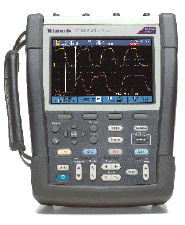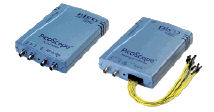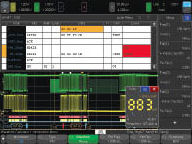Scope Out the Latest Technologies
Oscilloscope innovations lead to faster, more accurate testing.
January 1, 2013
Oscilloscopes have come a long way since The Heath Co. packaged a bunch of surplus World War II electronics together in 1947 and sold it as the O1 oscilloscope kit for $50, making it the first scope to gain wide acceptance. Since then, manufacturers have responded to the engineer’s need to test different aspects of increasingly complex products.
 Tektronix says its THS3000 series of portable oscilloscopes have a seven-hour battery life. |
“If you look at an engineer’s test bench, the scope is the centerpiece of their bench,” says Richard Markley, product planner for Agilent’s InfiniiVision oscilloscopes. “The oscilloscope is what they use most often, so we tried to focus on making a phenomenal scope. But engineers want to use them for other things.”
Those “other things,” such as mixed signal analysis, digital voltmeters, logic and protocol analyzers, math functions, and measurements, tended to slow down the primary function of the scope: processing and displaying signals. But just like the devices they test, oscilloscopes are getting faster, smaller and more advanced. Modern oscilloscopes are judged on the speed of their sample and update rates, as well as their ease of use and flexibility in offering the number of analog and digital channels, bandwidths and advanced functions that make them multi-use pieces of test equipment.
Fast and Easy Functionality
The speed at which waveforms are sampled can be the difference between seeing a rare anomaly and missing it while the data is being processed. When a signal is sampled, an oscilloscope needs time to preprocess it, write it to memory, and display it. While it’s doing that in real time, it’s not acquiring a signal.
For example, Aglilent says its latest scope, the InfiniiVision 4000 X-Series, samples 1 million waveforms per second (WFM/s), even with digital channels turned on. That brings it in line with the R&S RTO line of oscilloscopes from Rhode & Schwarz, which also hits 1 million WFM/s.
With all of an oscilloscope’s potential for advanced, specialized functions, manufacturers are also challenged by keeping the user interface simple and efficient. With the popularity of smartphones and tablet devices, it was a small leap to imagine touchscreen user interfaces for oscilloscopes.
“With where the touchscreen consumer devices are going, there’s clearly an opportunity to capitalize on that, and make things easier for our customers who are used to that,” says Markley.
To test the limits of that opportunity, Agilent spent more than two years researching and developing the InfiniiVision 4000 X-Series. During that time, the company put its new capacitive touchscreen interface in front of end users. The new touchscreen interface is more akin to a modern tablet than previous resistive (pressure-based) touchscreen technology, in that it allows fast zooming and scrolling.
“What we found was that if customers owned a tablet or a smartphone, they usually loved the touchscreen interface,” says Markley. “About half of the customers love it—and the other half’s first question was ‘Where is the off button for the touchscreen?’ It was not so much a break along different ages like you might expect. It really depended on whether they owned a touchscreen product.”
Released in November, the 4000 X-Series includes a 12-in. touchscreen user interface that allows users to draw a box on the screen around an anomaly and trigger on it, and an onscreen touchpad that can be used instead of the standard knobs. However, those knobs are still there for users who aren’t comfortable with the touchscreen interface. The 4000 X-Series also accepts mouse-based input.
 Pico Technology’s PicoScope is an example of a PC-based oscilloscope. |  The Agilent InfiniiVision 4000 X-Series oscilloscope features a tablet-like touchscreen. |
Flexible and Expandable Options
In addition to the user interface options, Markley says the InfiniiVision 4000 X-Series was designed to be flexible and upgradeable. The series includes 200-, 350- and 500-MHz, and 1- and 1.5-GHz models. It also includes the capabilities of five instruments on one unit: oscilloscope, digital channels, protocol analysis, digital voltmeter and a dual-channel WaveGen function/arbitrary waveform generator.
“We’ve been hearing a lot about how engineers’ needs are changing so fast,” Markley says. “Project needs and requirements for test equipment are moving quickly. Our customers were getting frustrated with having to buy a new scope every few years to keep up with those requirements.”
To counter that frustration, Markley says most features of the 4000 X-series are upgradeable, except for having to choose between either two or four analog channels at the time of purchase.
A Diverse Market
Other manufacturers have taken different approaches when it comes to offering flexibility and upgradeability in an oscilloscope by tying it and its software to a workstation.
For instance, Pico Technology offers PC-based oscilloscope software and hardware that it says can turn your workstation into a test and measurement lab. Its PicoScope 6 software, which is provided free with purchase of one of the company’s PicoScope USB products, allows the company to provide the features of an oscilloscope, spectrum analyzer and signal/waveform generator, all of which can be updated via free downloads.
National Instruments calls its PC-based oscilloscopes digitizers, because they can be defined with software to perform the functions of oscilloscopes or other digital measurement instruments. They can be programmed using NI’s free NI-SCOPE driver software, which comes with more than 50 prewritten example programs. The NI-SCOPE Soft Front Panel provides an interface that looks like a traditional, dedicated oscilloscope.
While PC-based oscilloscopes can be plugged into a laptop and taken out into the field, they’re not the only option for engineers who need to analyze on the go. A number of manufacturers have seen the need for smaller form factor oscilloscopes in today’s mobile workplace.
Tektronix’s answer to the portability problem is its THS3000 series of oscilloscopes. With a weight of 4.8 lbs., seven hours of battery life and four isolated channels, the THS3000 series is built for use in demanding conditions, according to the company. Models are available with either 100MHz and 2.5 GS/s maximum sampling rate, or 200MHz and 5 GS/s sample rate performance. The 10,000-point record length on all four channels enables the capture of extra waveform details at high sample rates. Scopes in the series include 21 automated measurements, built-in limit testing, and waveform math and data logging capabilities. They also include a USB port for adding additional flash storage or downloading data and screenshots to a PC.
Extech Instruments’ MS6000 series of portable digital oscilloscopes have 5.6-in. color LCDs. Each of the three scopes in the series—the 60MHz MS6060, the 100MHz MS6100 and the 200MHz MS6200—feature 23 automatic measurements and a waveform recorder to capture/replay up to 1,000 waveform screens to their installed 2GB microSD cards. According to the company, the series has a battery life of three hours.
Yet another take on expanding oscilloscope functionality can be seen in Yokogawa’s ScopeCorders. These multi-channel test and measuring solutions combine oscilloscopes with paper chart recorders. In addition to displaying signals on screen, the ScopeCorders can record to paper and/or memory for 30 days or more.
We’ve just exposed the tip of the iceberg when it comes to advancements in oscilloscopes. When comparing oscilloscopes, be sure to do your research by visiting the manufacturers’ websites, and check out distributors, such as Saelig and Mouser Electronics, for a variety of oscilloscope solutions. DE
Jamie Gooch is DE’s managing editor. Contact him via [email protected].
MORE INFO
Subscribe to our FREE magazine, FREE email newsletters or both!
About the Author
Jamie Gooch is the former editorial director of Digital Engineering.
Follow DE





